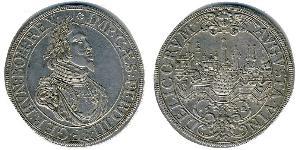1 Thaler (Verkauft für $87.0)
1595, Archduke Ferdinand II. Large Silver Thaler Coin. Hall mint!
Mint Period: 1564-1595
Mint Place: Hall (Tyrol).
State: Holy Roman Empire
Denomination: Thaler (also Taler)
Reference: Davenport 8097, Moser & Tursky 273, KM-. R!
Condition: Struck on an irregular planchet with a large piece of missing metal and light planchet striae, minor hits in reverse and edge, otherwise a nice XF!
Weight: 27.69gm
Diameter: 39mm
Material: Silver
Obverse: Crowned and armored half-length bust right, holding sword and scepter.
Legend: . FERDINAND : D : G : ARCHID : AVSTRIAE (AE in monogram)
Comment: Floral ornamentation on lower front part of of armor!
Reverse: Crowned coat of arms within Order of the Golden Fleece, Tyrolian eagle in center.
Comment: Spanish Arms of Castile & Leon in lower left part of shield. Bohemian lion in upper right quarter!
Legend: DVX . BVRGVNDIE (possible legend error, this should be BVRGVNDIAE) . COMES . TIROLIS
A wonderful old struck silver thaler (perdecessor of the dollar) variation!
In the Holy Roman Empire, the Thaler was used as the standard against which the various states' currencies could be valued. The first documented mention of Hall dates back to 1256. Since the 13th century the salt mine in the Halltal north of Hall formed the main industry of the town and its surroundings. The salt was exported to Switzerland and some regions in Germany. In 1303 Hall became a town and in 1477 it got the right of coinage.
em>.
Ferdinand II, Archduke of Further Austria (Linz, June 14, 1529 – January 24, 1595) was ruler of Further Austria including Tirol.
Archduke Ferdinand of Austria was the second son of Ferdinand I, Holy Roman Emperor and Anna of Bohemia and Hungary. He was a younger brother of Emperor Maximilian II. At the behest of his father, he was put into charge of the administration of Bohemia in 1547. Also, he led the campaign against the Turks in Hungary in 1556.
In 1557, he was secretly married to Philippine Welser, daughter of a patrician from Augsburg, with whom he had several children. The marriage was only permitted by Emperor Ferdinand I in 1559 under the condition of secrecy. The children were to receive the name "of Austria" but would only be entitled to inherit if the House of Habsburg would become totally extinct in the male line (Also see: morganatic marriage). The sons born of this marriage received the title Margrave of Burgau, an old Habsburg possession in Further Austria. The younger of the sons, who survived his father, later received princely rank, becoming Fürst zu Burgau.
After his father's death in 1564, Ferdinand received the rulership over Tyrol and other Further Austrian possessions under his father's will. However, he remained as governor of Bohemia in Prague until 1567 following the wishes of his brother Maximilian II.
In his own lands, Ferdinand made sure that the Catholic counterreformation would prevail. Since he was an avid collector of art, the collection of the famous Castle Ambras was started in his time. He had begun to work on it even during his time in Bohemia and subsequently moved it to Tyrol. In particular, the gallery of portraits and the collection of armor were highly expensive, which is why the archduke had incurred a high level of debt. Today, those collections are in the Kunsthistorisches Museum in Vienna.
After the death of Philippine in 1580, he married Anne Catherine, a daughter of William I, Duke of Mantua, in 1582.
Archduke Ferdinand died on January 24, 1595. Since his sons from the first marriage were not entitled to the inheritance, and the second produced only surviving daughters, Tirol was reunified with the other Habsburg lines. His daughter from the Mantuan marriage became the Empress Anna, consort of Emperor Mathias, who received his Further Austrian inheritance.
Karl II of Austria, Margrave of Burgau, morganatic son of Ferdinand II, Archduke of Austria married Sibylle (1557-1627), daughter of William, Duke of Jülich-Berg-Ravensberg-Kleve-Mark (28 July 1516 - 5 January 1592), and Maria, Archduchess of Austria, daughter of Ferdinand I, Holy Roman Emperor.
Only 1$ shipping for each additional item purchased!

|
Beigetragen von:
anonymous 2015-12-13 |
|
||
|
||
|
||
|
||
|
||
1/12 Anna Britisch-Indien (1858-1947) Kupfer George V (1865-1936)
Diese Gruppe hat 6 Münzen / 1 Preise
⇑
3 Mark Grand Duchy of Baden (1806-1918) Silber Friedrich II. ...
Diese Gruppe hat 44 Münzen / 64 Preise
⇑

-600-300-dggKbzbiyj0AAAFR82WWypnu.jpg)

-300-150-h90Kb0OMEa8AAAFCkNglyfgY.jpg)
 English
English





-300-150-02B_AAEB7QEAAAElzZdzfAQA.jpg)

-300-150-qacKbzbiAMkAAAFF4Fl4ouT_.jpg)






